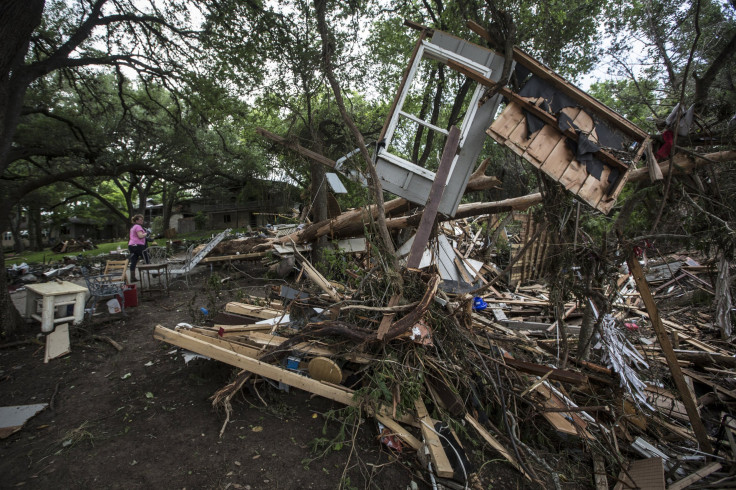Texas Flooding 2015: Without Flood Insurance, Homeowners Face Challenges In Rebuilding Homes

The 40-foot wave of water was unlike anything residents in the small town of Wimberley, Texas, had ever seen. As the Blanco River surged, it wrenched and snapped trees like twigs, flipping cars and tugging apart entire houses before whisking them away. In the wreckage of his home, one man, looking shell-shocked, held a frame of photos as he surveyed the detritus – a broken guitar, plates scattered across what was once a yard – around the half-wall of his home that remained standing.
After record storms caused unprecedented flooding throughout Texas and Oklahoma over Memorial Day weekend, homeowners are now sorting through the wreckage. But many are unlikely to have purchased the special flood insurance necessary to pay for the damage and destruction wrought by these storms, experts said, and even those who did may find their coverage insufficient. In recent years, the number of flood insurance policies in Texas has declined, federal numbers show.
“I think less than half of the homeowners affected had flood insurance,” Mark Hanna, spokesman for the Insurance Council of Texas, which represents 500 insurance companies, estimated. He said he knew personally of one family whose second home, uninsured against floods, was damaged by the Blanco River, and he had heard reports of many others whose homes were damaged but that lacked flood insurance.
Officials are still surveying and assessing the wreckage from these storms, in which at least 17 people were killed and hundreds of homes damaged. By Tuesday, Texas Gov. Greg Abbott had declared states of disaster in 32 counties. The Federal Emergency Management Agency (FEMA) is conducting preliminary damage assessments in the state, but before it can offer federal assistance, the governor has to ask for it. Texas officials have warned that rivers could continue flooding for weeks, while the National Weather Service has predicted that more heavy rain in the coming days could trigger more flash flooding.
A bath tub & sink left after a house was completely destroyed by the river. #WimberleyFlooding pic.twitter.com/tlGjTKy7Ks
- Marisol Gonzalez (@MarisolKZTV) May 26, 2015Most people whose homes were damaged or destroyed probably did not have flood insurance for three primary reasons, Mark Ticer, a Dallas-based lawyer who specializes in insurance law, explained: They may be unable to afford insurance, they may not be aware that it exists, or they may have simply believed that their homes were in places that would be untouched by floods. “A lot of people don’t understand that floods are not typically covered in a homeowner’s policy,” Ticer added.
Residents of Wimberley were among those who may have thought their homes were on high ground and, thus, safe. “There were a lot of people whose homes were way above normal flood stage and did not have flood insurance,” Cathy Moreman, executive director of the Wimberley Chamber of Commerce, said. “Many of the homeowners that lived along the river were elevated enough above the river that no one ever thought these homes would be flooded.”
Mortgage lenders typically require people to buy flood insurance if their homes are in flood zones, said Tom Baker, a scholar in insurance law at the University of Pennsylvania Law School. “But that is not very carefully policed,” he noted. If people own their homes outright, however, no one can require them to purchase protection against floods.
Historically, flood insurance has not been included as part of private homeowners’ insurance, although it is available separately at market rates. Rather, those who want protection against floods typically buy it through a FEMA initiative called the National Flood Insurance Program, which underwrites part of the cost, making flood insurance more affordable. In 2012, the average premium through the National Flood Insurance Program cost $650 per year.
However, this low price tag has had at least one unintended consequence: It fails to discourage people from living in areas with a high risk of floods. The ironic result is that the availability of insurance puts even more homes at risk, should storms and flooding occur.
“One of the reasons we have people living in flood plains is because of subsidized flood insurance,” Baker said. “Prices haven’t reflected the risk, so things are built where they shouldn’t be.”
But a key change has occurred in recent years: The national program is in transition, aiming to make the cost of flood insurance more accurately reflect the risks of living in a flood zone. As premiums rise, more people are dropping flood insurance, including in Texas, where the number of flood insurance policies has been dropping steadily since at least 2011, according to data from FEMA.
As of September 2014, Texas had 602,797 such policies in force -- a 4.49 percent decrease from the previous year. From 2011 to 2012, the number of flood insurance policies declined by 3 percent, and from 2012 to 2013 they declined by 2 percent. By comparison, in 2014 Texas had 4,403,324 homeowner's insurance policies, according to Jerry Hagins, spokesman for the Texas Department of Insurance.
Even for those who had purchased flood insurance, the cost of repairs could be extremely expensive, experts said. Flood insurance through the federal government covers a maximum of $250,000 for one- to four-family homes. From 2008 to 2012, the average flood insurance claim amounted to nearly $42,000.
For homeowners who want to insure their homes against the next potential wave of damage, it’s probably too late since it usually takes 30 days for flood insurance policies to go into effect. As the National Flood Insurance Program website cautions, “It’s important to buy insurance before the storm approaches and the floodwaters start to rise.”
© Copyright IBTimes 2024. All rights reserved.






















